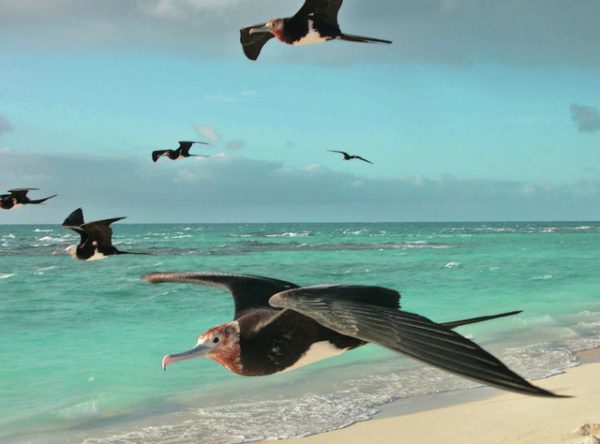Published in the Ocean Watch column, Honolulu Star-Advertiser © Susan Scott
July 30, 2016
I had the blues last week. Our little dog, Lucy, died, and the storm spoiled my usual stress reliever of snorkeling. Nor did I feel like walking the beach. Besides when it drizzled, Lucy and I walked there for years. Going alone made me miss her even more.
 A flock of great frigate birds rides tradewinds.
A flock of great frigate birds rides tradewinds.
©2016 Susan Scott
But then Craig announced he was off to the beach to check the windsurfing conditions. I dragged myself there with him, and as if summoned to lift my spirits, a flock of great frigate birds appeared overhead.
 Craig & Lucy.
Craig & Lucy.
©2016 Susan Scott
About 15 of the black birds, with wingspans of 6 feet, stayed up high, their bodies looking like cutouts against the gray sky. Three birds, however, drifted so low we could see their faces and determine their sex — one all-black male, two white-chested females.
Oh, how those seabirds rode the wind. They were in their element, gliding up, down, forward and backward without a single flap of wings. So relaxed were the birds in the stormy weather that one of the females began, while floating in midair, to preen her feathers.
We Hawaii residents know that when it comes to flying, frigate birds, or iwa, are tops. Now though, in a study published this month in the journal Science, we find out how these seabirds manage some of their amazing feats.
On an island off Mozambique, researchers attached tiny solar-powered transmitters to 24 adult and 25 juvenile frigate birds to measure their heart rate, wing beats, acceleration, altitude and GPS coordinates. The results are mind-boggling. One adult flew continuously for 48 days, averaging 261 miles per day. Juveniles flew even farther than their parents, one covering 34,000 miles in 185 days. (Earth’s circumference is 25,000 miles.) The young frigate bird rested on islands only a few hours at a time, totaling less than four days during its six-month journey.
Frigate birds ride tradewinds, but to get even better mileage, they take advantage of clouds, formed when warm air rises. Since warm air inside clouds rises even faster, the birds pop in and ride the up escalator, sometimes ascending to an astonishing 13,000 feet.
From that altitude a frigate bird can get up to 30 miles soaring distance, often enough to find another cloud for another free ride.
The birds travel these long distances because they follow migrating tuna, big fish that drive little fish to the surface where frigate birds can snatch them up. Although they sometimes steal meals from other seabirds, frigate birds catch most of their own fish.
There’s nothing like watching frigate birds fly to get my spirit soaring. The birds showed up just when I needed them. I’ll consider their timely appearance as a tribute to a remarkable dog.